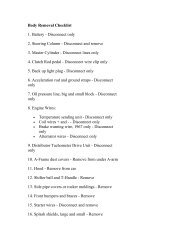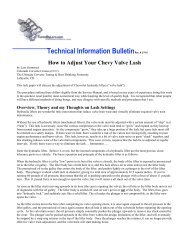Differential Rebuild Instructions - The Corvette Restoration Page
Differential Rebuild Instructions - The Corvette Restoration Page
Differential Rebuild Instructions - The Corvette Restoration Page
You also want an ePaper? Increase the reach of your titles
YUMPU automatically turns print PDFs into web optimized ePapers that Google loves.
Pinion Trial Assembly<br />
I have found it is easiest to assemble the pinion without a crush sleeve until the<br />
correct pinion depth has been established. When initially installing the pinion I slowly<br />
tighten the pinion nut until the preload is within the assembly specifications.<br />
Initial Carrier Assembly<br />
I have also found it works well to assemble the carrier snug but not tight during trial<br />
assemblies so it is easier to remove and replace during the several attempts necessary to<br />
find the shim combination for correct pinion depth and backlash.<br />
After installing the pinion, the first<br />
adjustment I make is backlash. I believe a<br />
clear indication of pinion depth can only<br />
be obtained when the backlash is within,<br />
or very close to specifications. I have<br />
found the backlash will change about<br />
0.007” for each 0.010” that the carrier is<br />
moved. If I want to decrease the backlash<br />
by 0.007” I move the carrier 0.010” closer<br />
to the pinion. If I want to increase the<br />
backlash by 0.007” I move the ring gear<br />
0.010” farther away from the pinion. This<br />
is not exact for all ring & pinion sets, but<br />
it is a good general guideline.<br />
Adjusting Backlash<br />
Checking the Pattern<br />
After setting the backlash the next setting to check is the pinion depth. When<br />
checking the pinion depth I use only genuine gear marking compound. Gear marking<br />
compound gives a clear indication of gear contact without running or smearing. I<br />
usually mix a little oil with the marking compound so that it is smooth but not runny. I<br />
brush three or four of the ring gear teeth with a moderate coat of compound in two<br />
different places on the ring gear. <strong>The</strong>n I rotate the ring gear past the pinion gear four or<br />
five times to obtain a good pattern.<br />
Important Pattern Information!<br />
Reading the contact pattern is easy as long as I am not mislead or sidetracked. <strong>The</strong><br />
only part of the pattern that helps me set the pinion depth correctly is the contact<br />
position with regards to the face and flank of the teeth. If the contact pattern appears to<br />
be towards the heel or the toe of the ring gear teeth I pay no attention and look only at<br />
the pattern position from face to flank. <strong>The</strong> pattern will also change from heel to toe<br />
but in most cases an ideal heel to toe pattern can not be achieved. Trying to obtain a<br />
Installation Kit <strong>Instructions</strong> 5




